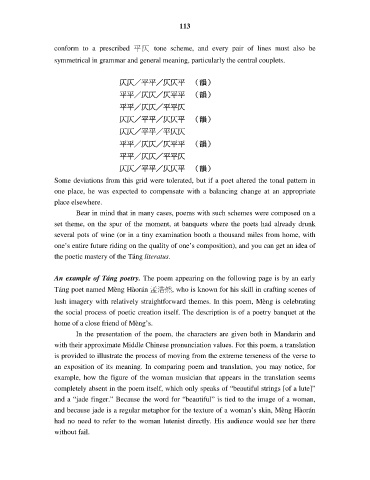Page 121 - EALC C306/505
P. 121
113
conform to a prescribed 平仄 tone scheme, and every pair of lines must also be
symmetrical in grammar and general meaning, particularly the central couplets.
仄仄/平平/仄仄平 (韻)
平平/仄仄/仄平平 (韻)
平平/仄仄/平平仄
仄仄/平平/仄仄平 (韻)
仄仄/平平/平仄仄
平平/仄仄/仄平平 (韻)
平平/仄仄/平平仄
仄仄/平平/仄仄平 (韻)
Some deviations from this grid were tolerated, but if a poet altered the tonal pattern in
one place, he was expected to compensate with a balancing change at an appropriate
place elsewhere.
Bear in mind that in many cases, poems with such schemes were composed on a
set theme, on the spur of the moment, at banquets where the poets had already drunk
several pots of wine (or in a tiny examination booth a thousand miles from home, with
one’s entire future riding on the quality of one’s composition), and you can get an idea of
the poetic mastery of the Táng literatus.
An example of Táng poetry. The poem appearing on the following page is by an early
Táng poet named Mèng Hàorán 孟浩然, who is known for his skill in crafting scenes of
lush imagery with relatively straightforward themes. In this poem, Mèng is celebrating
the social process of poetic creation itself. The description is of a poetry banquet at the
home of a close friend of Mèng’s.
In the presentation of the poem, the characters are given both in Mandarin and
with their approximate Middle Chinese pronunciation values. For this poem, a translation
is provided to illustrate the process of moving from the extreme terseness of the verse to
an exposition of its meaning. In comparing poem and translation, you may notice, for
example, how the figure of the woman musician that appears in the translation seems
completely absent in the poem itself, which only speaks of “beautiful strings [of a lute]”
and a “jade finger.” Because the word for “beautiful” is tied to the image of a woman,
and because jade is a regular metaphor for the texture of a woman’s skin, Mèng Hàorán
had no need to refer to the woman lutenist directly. His audience would see her there
without fail.

